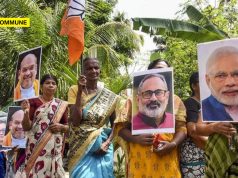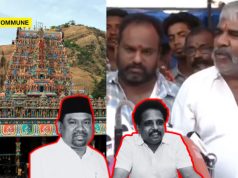
A long buried under garbage and soil, a Ganesha temple was unearthed in Salem’s Uthamasolapuram. This discovery delivers a tight slap to self-proclaimed ‘Dravidian historians‘ who distort history by claiming that the worship of Lord Ganesha began only after the battle of Vatapi.
Local residents had long claimed that a temple named ‘Vithaga Vinayagar‘ had been lost beneath heaps of garbage in Uttamasholapuram, near Thirumani Muttharu. Recently, the organization “Pasumai Tamizhagam” cleared away the debris and uncovered the statue of Lord Ganesha, a two-foot sculpture carved from a single rock. Surrounding temple pillars, though damaged, were also discovered.
The news of the idol’s recovery drew local people who gathered to worship at the Ganesha temple. They thanked the NGO for their efforts. According to local folklore, the temple may be about 1,500 years old and is believed to be where poetess Avvaiyar composed the Vinayakar Agaval. Residents call on the government to protect the temple and restore it as a place of worship.
விநாயகர் வாதாபி இறக்குமதி…!
பிள்ளையார் வடநாட்டு கடவுள்…!!
மீண்டுமொரு முறை சுக்கு நூறான திராவிட உருட்டுக்கள்!!சேலம் உத்தமசோழபுரத்தில் 1500 ஆண்டுகள் பழமையான விநாயகர் திருமேனி கண்டுபிடிப்பு.. pic.twitter.com/DE9SwCm537
— Hindu Munnani (@hindumunnani_tn) August 28, 2024
This was not an isolated incident. In 2021, not only Vinayagar a 5th-century stone sculpture of Vinayaki (the female form of Lord Ganesha) from the pre-Pallava period was also unearthed by a team from the Archaeological Survey of India (ASI) in a village in Chengalpet district, about 100 km south of Chennai. The three-foot-tall sculpture, carved from granite, was a rare find with inscriptions in early Tamil script detailing the donor.
While Lord Ganesha was widely worshipped in Tamil Nadu, idols of Goddess Vinayaki with a trunk were exceptionally rare. Remarkably, another sculpture with similar inscriptions and a comparable seating position was discovered about a kilometer away in Irumbedu village near Cheyyur. This second sculpture, under examination, was believed by locals to be Goddess Gangai Amman. The community revered both sculptures in open areas, rather than within any temple.
The inscriptions on the sculptures read “Jeyam Patta Muthiravarigan Madavati,” which archaeologists interpreted as a record of a donation by an individual named Madavati to commemorate a victory. Assistant epigraphist P.T. Nagarajan said these early Tamil inscriptions dated back approximately 1,500 years. Vinayaki was predominantly worshipped in North India and was notably rare in Tamil Nadu, and the current discovery is astonishing. The ASI team, including assistant archaeologists Dr. R. Ramesh and M. Prasanna, visited the village in response to local alerts about these unique sculptures. Their findings were featured in the ASI’s annual report on Indian Epigraphy.
Subscribe to our Telegram, WhatsApp, and Instagram channels and instantly get the day’s best stories.




